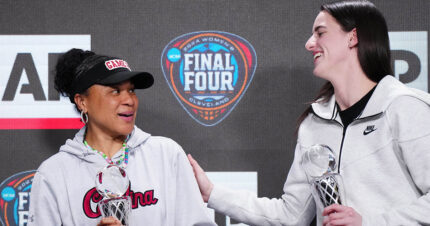UConn’s 60-point rout of Mississippi State in the 2016 NCAA tournament, and their subsequent overtime loss to the Lady Bulldogs in this year’s Final Four recycled the debate on whether dominant entities hurt or benefit their sports.
Journalists and basketball fans have opined that UConn games are boring, that their 111-game winning streak was evidence that women’s basketball is underdeveloped, and they would be more interested if Connecticut had an adversary in the mode of the Lakers and Celtics of the 1980’s.
It is likely that those fans would not suddenly shift their viewing habits in that case. They have tolerated dominance in the sports they prefer to follow.
Dominant teams and individuals foster progress, and their influence re-imagines sports. Not only have the UConn women helped brand the game and provided a benchmark for opponents, they don’t win national championships every year.
The Huskies were shut out of national titles between 2004 and 2009, then they didn’t win championships in 2011 or 2012. Baylor, Notre Dame, Rutgers and Duke all rose as highly competitive programs.
In addition, UConn was preceded by dynasties at Tennessee, Louisiana Tech, and Immaculata – all of which advanced the game and helped establish standards of excellence, going back to the early 1970’s.
UConn’s own rise did not occur in a vacuum. In head coach Geno Auriemma‘s first two seasons, they finished seventh in The Big East, during a period where Old Dominion was a national power and the University of Tennessee was rising.
Powerhouse teams also spawn coaches, assistants and managers.
Auriemma has a coaching tree that includes former Huskie All-America Shea Ralph having been an assistant at Pitt, Tonya Cardozo as head coach at Temple, Jamelle Elliott at Cincinnati, and Jen Rizzotti at Hartford and George Washington. His former assistant Charlene Curtis coaches at Wake Forest. Former UConn All-American Carla Berube has coached Tufts to four consecutive Division III women’s Final Fours.
UConn’s prowess has also helped further fan and student interest in the game in which other major colleges have benefited. Young players grew up admiring their stars, some of whom like former WNBA legend Dawn Staley have became college coaches.
A few years ago, South Carolina women’s basketball drew just over 4,000 fans per game. Now they average over 14,000 per game, the most in the NCAA. The 2017 women’s Final Four had three first-time participants, and in the championship game, both South Carolina and Mississippi State were newcomers.
The 1990’s Chicago Bulls and 1960’s & 1970’s UCLA NCAA men’s basketball teams were dynasties that were never accused of hurting their sports. Fans who state that the college game would be better served if the Lady Huskies had a rival forget that the 1990’s Bulls faced different NBA West champs each year in the Finals – the Lakers, the Sonics, the Suns and the Blazers.
At their peak, the Bulls did not have a Western rival. Even in the East, they went from facing Detroit to New York to Indiana during their reign.
The UCLA men’s basketball dynasty didn’t have a constant foe as well. Dayton, North Carolina, Purdue, Jacksonville, Florida State and Memphis State all bowed to Bruin teams in NCAA finals. But fan interest grew during the dynasty, enough that UCLA played a regular season game against Houston in the Astrodome, and in the mid-1970’s, the men’s Final Four became a national happening.
Similarly, appreciation for the men’s pro game grew as the Bulls overcame the Pistons and Lakers. NBC aired NBA Inside Stuff. The All-Star Game and dunk contest were the stuff of legend. The brand became global, leading to professional players on FIBA and Olympic teams by 1992.
The 1992 USA Basketball Dream Team blew away their competition by 44 points per contest, but it was not bad for the game. Fans followed them around Barcelona as if they were a rock band, and their smooth transition play – on some fast breaks the ball rarely touching the floor – set a standard for the rest of the world.
Other national teams hired coaches from the U.S., sent players to NCAA universities, and soon, Spain, Argentina, Yugoslavia were winning FIBA World Cups.
Lithuania, Italy and Russia were highly competitive after 1992. NBA players joined the national rosters of the German, Canadian, and Puerto Rican national basketball teams. Around the globe, national under-19 men’s teams have improved. The days of asking for autographs and posing for pictures with Team USA has passed. When Spain and Argentina won World Cups, they have defeated USA Basketball at its own game of drive-and-kick.
Dominant teams and athletes have inspired imitators, forged widespread weight training and conditioning advances, led to diversity in recruiting, and helped games evolve in terms of forward passing, large agile football linemen, relief pitching, more parity in FIBA men’s basketball, and scoring defensemen in hockey.
A rising tide can lift athletics boats. The Cleveland Browns, who played in 10 consecutive championship games in the AAFC and NFL, were coached by Paul Brown, whose innovations such as face masks and film study were adopted by his competitors. Brown’s coaching tree included Don Shula and Chuck Noll.
The dominance of the 1960’s Boston Celtics inspired two coaches, Alex Hannum of the 1966-67 Philadelphia 76’ers, and Bill Sharman of the 1971-72 Los Angeles Lakers, to convince Wilt Chamberlain to play more like Celtic center Bill Russell. The 1967 Sixers went 68-13 and won a championship, the 1972 Lakers won 33 straight and finished 69-13. Boston had provided a template.
Dominance in individual sports has the same effect. Martina Navratilova in tennis and Tiger Woods in golf were athletes whose championships inspired their opponents to devote more attention to conditioning. And Woods’ years at the top of his game attracted more fans to the PGA Tour, both on television and in person.
Power tennis is now commonplace, in Serena Williams and many others. Without a dominant presence, how does a game evolve? Sports are as Darwinian as technology, business, or popular music. Nothing succeeds like success.
Remember the Washington NFL teams that won three Super Bowls under Coach Joe Gibbs? While they won with three different quarterbacks, the constant was a massive offensive line known as “The Hogs”. Some weighed nearly 300 pounds.
Today, most NFL offensive linemen are that size.
In the late 1940’s, the New York Yankees turned a former starting pitcher, Joe Page, into a late relief pitcher. Page saved 17 games in 1947, though the statistic, and the term did not exist. In 1949, Page saved 27 games, though no one recorded the stat, and there were no awards for such. He was selected to the All-Star team in that role.
In his footsteps, pitchers such as Brooklyn’s Clem Labine, Pittsburgh’s Elroy Face and the White Sox’s Hoyt Wilhlem specialized as closers. Labine has been retroactively credited with 19 saves in 1956 and 17 in 1957. The success of Joe Page as an element of the Yankee dynasty moved other managers to develop similar roles on their own pitching staffs – roles for which statisical metrics did not yet exist.
It is worth noting that Bill Russell played his entire pro career for a dynasty, yet no one thought to tally blocked shots until 1973, four years after he retired.
Dynasties move other organizations, colleges and coaches to broaden their recruiting reach, upgrade their training regimens, implement next generation scouting technology, and adjust their strategies on the field, ice, court, or diamond.
The great Wishbone offenses of the Oklahoma football teams proliferated not only throughout The Big 8 conference, but by the early 1970’s, schools from the East Coast to the West Coast were employing the Wishbone T formation or variants.
Speaking of West Coast, that football offense, often credited to the 49’ers Coach Bill Walsh (but actually an attack he learned as a Paul Brown assistant on the late 1960’s expansion Cincinnati Bengals), was everywhere a few years after San Francisco won four Super Bowls.
Developments such as 3-4 defenses, nickel secondaries, scouting historically Black colleges, and shotgun-formation offenses all came from dynamic coaches on powerful teams.
To paraphrase Gordon Gecko, “Dominance is good”.
If a sports fan doesn’t enjoy a particular sport or team, the remote control is their friend. But while that fan is not watching, the losers experience phases of awe, followed by disappointment, appraisal, and emulation. Call them the athletic phases of defeat.
In any endeavor, to learn to be, or even beat the best, one must play the best. Whether that involves your parent on a garage basketball court, an older sibling, or UConn women’s college basketball, the teaching moments are invaluable. Let’s try to embrace them.



